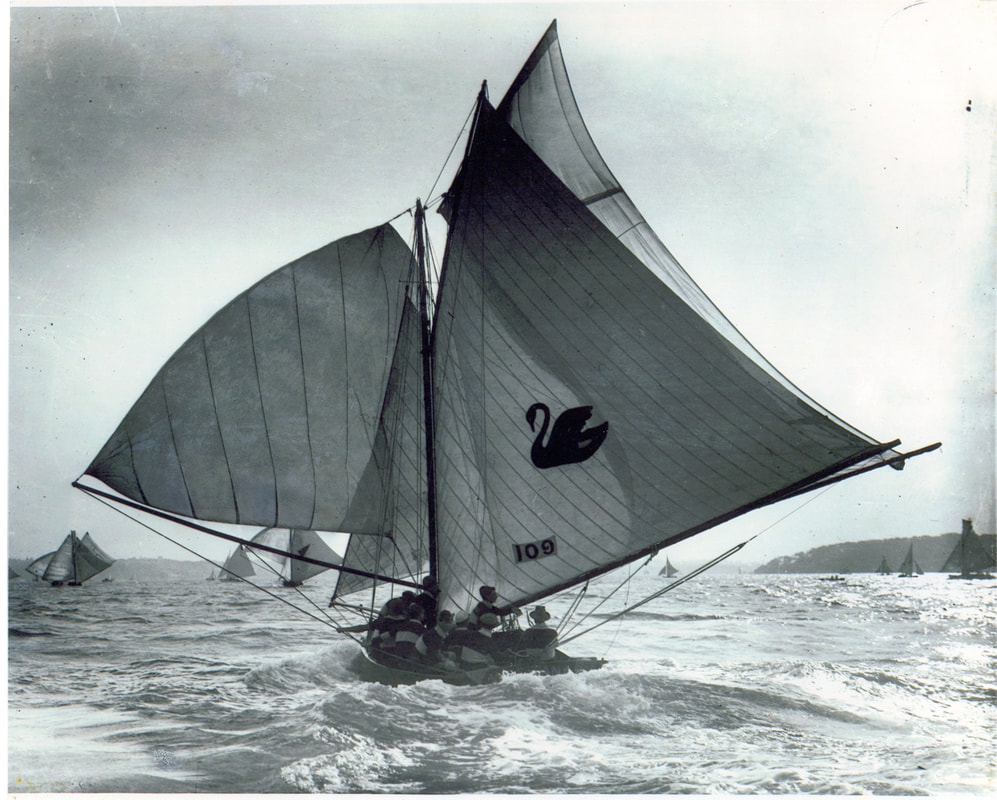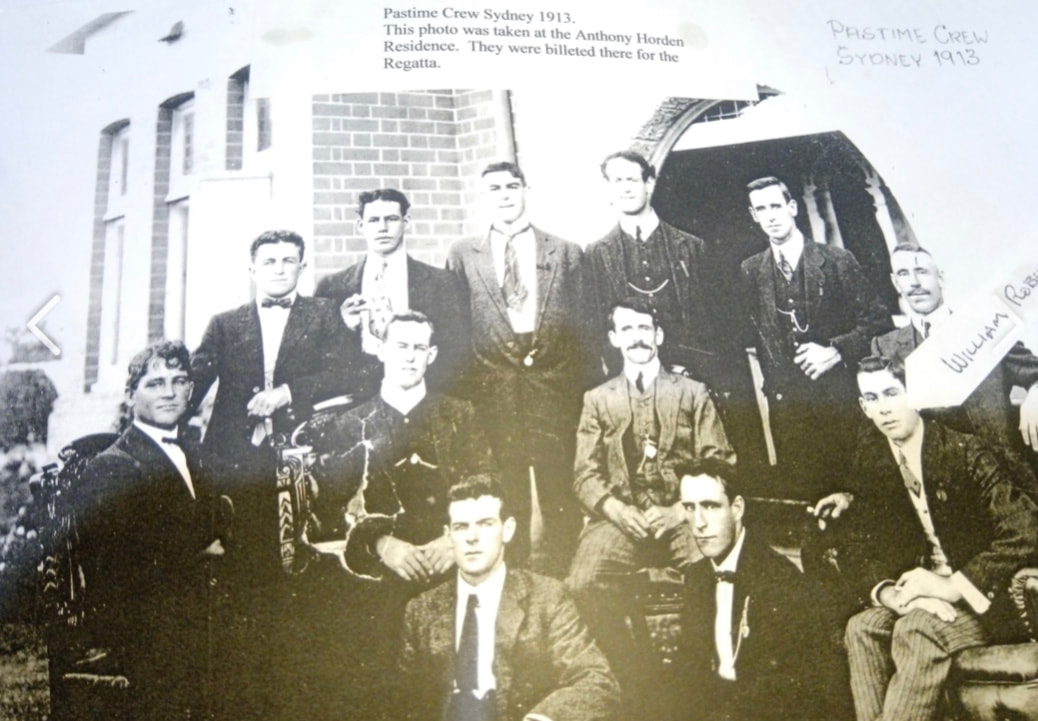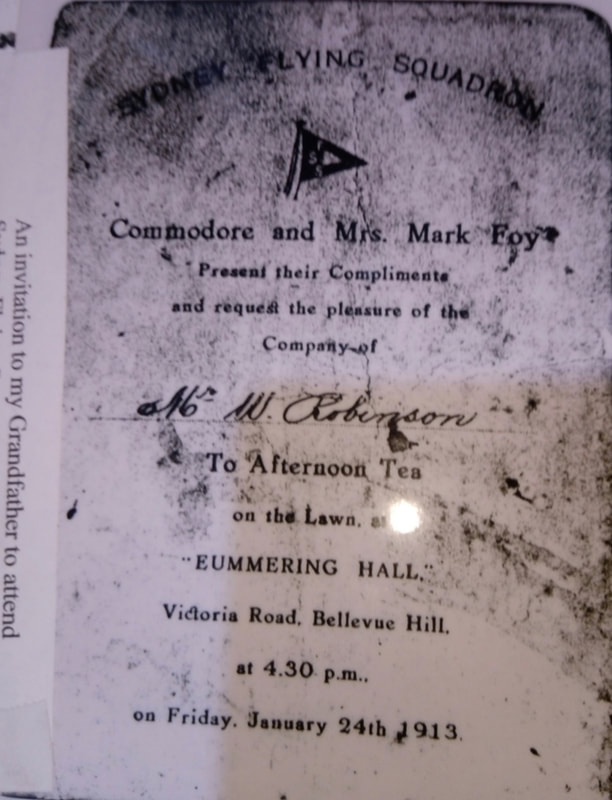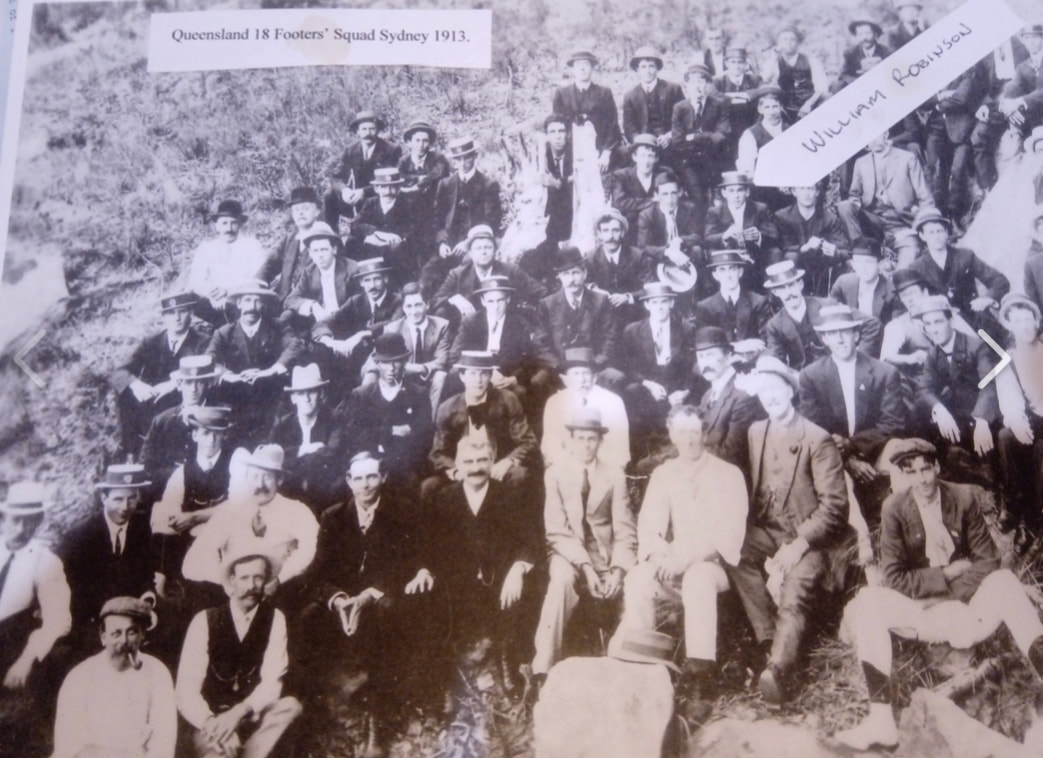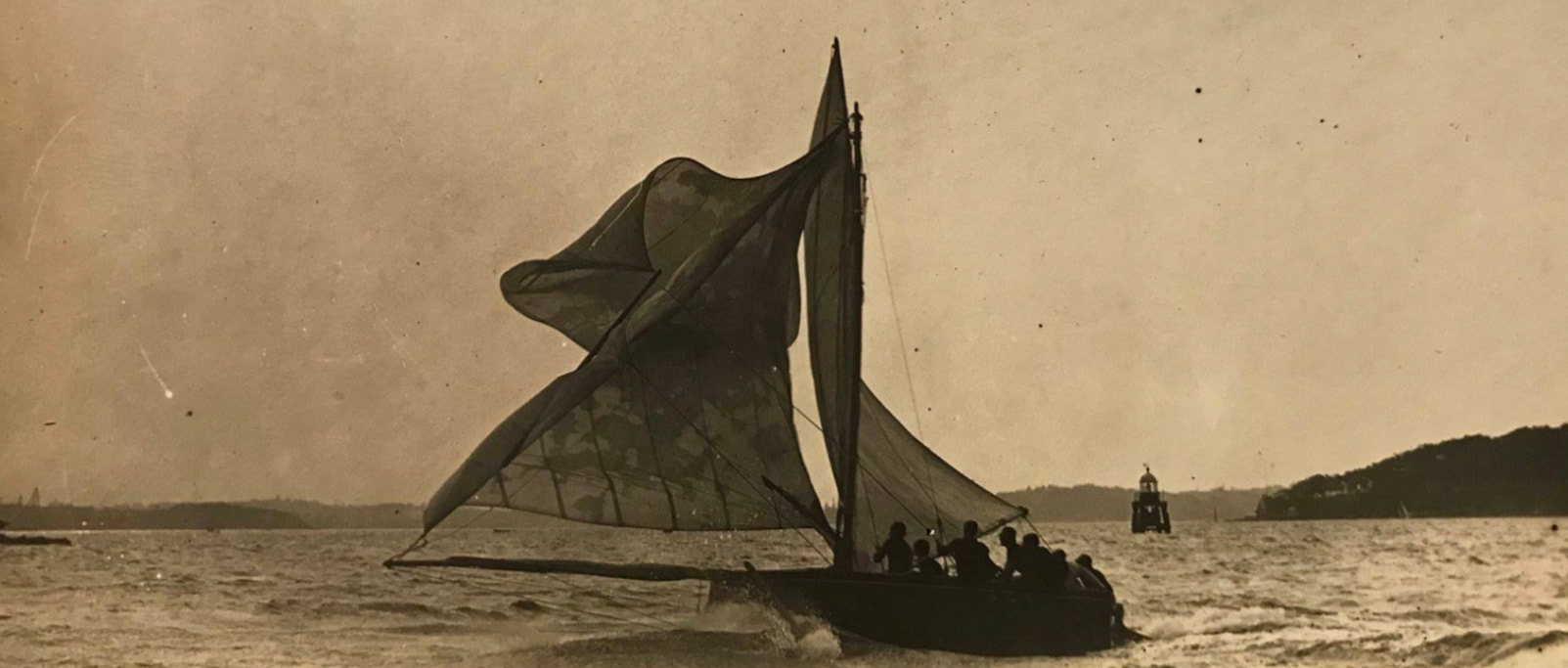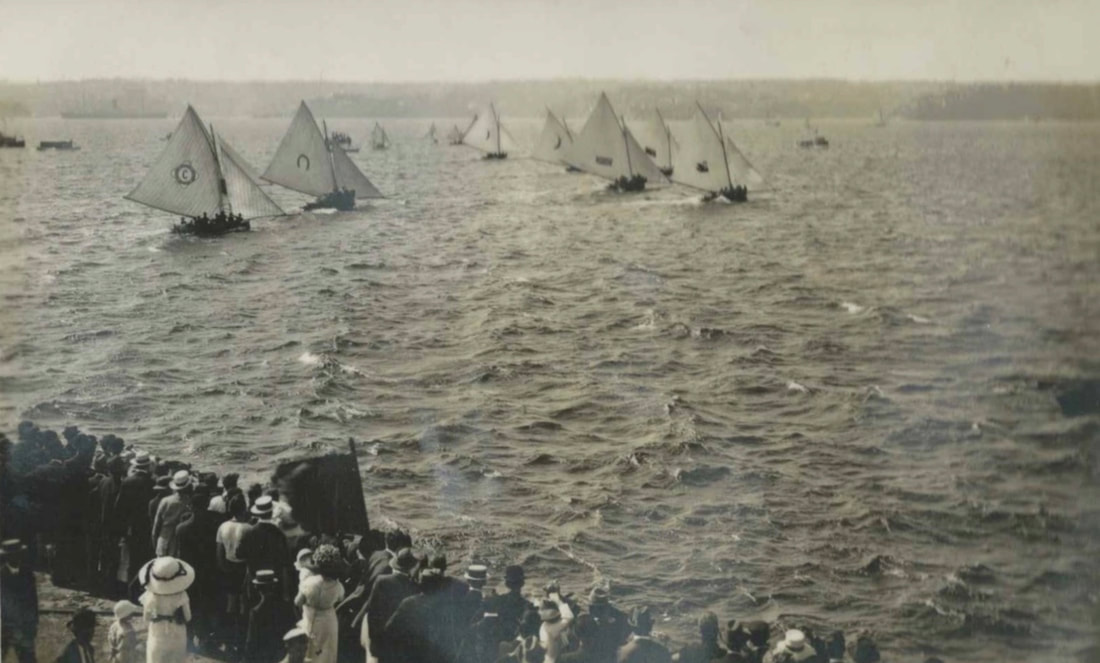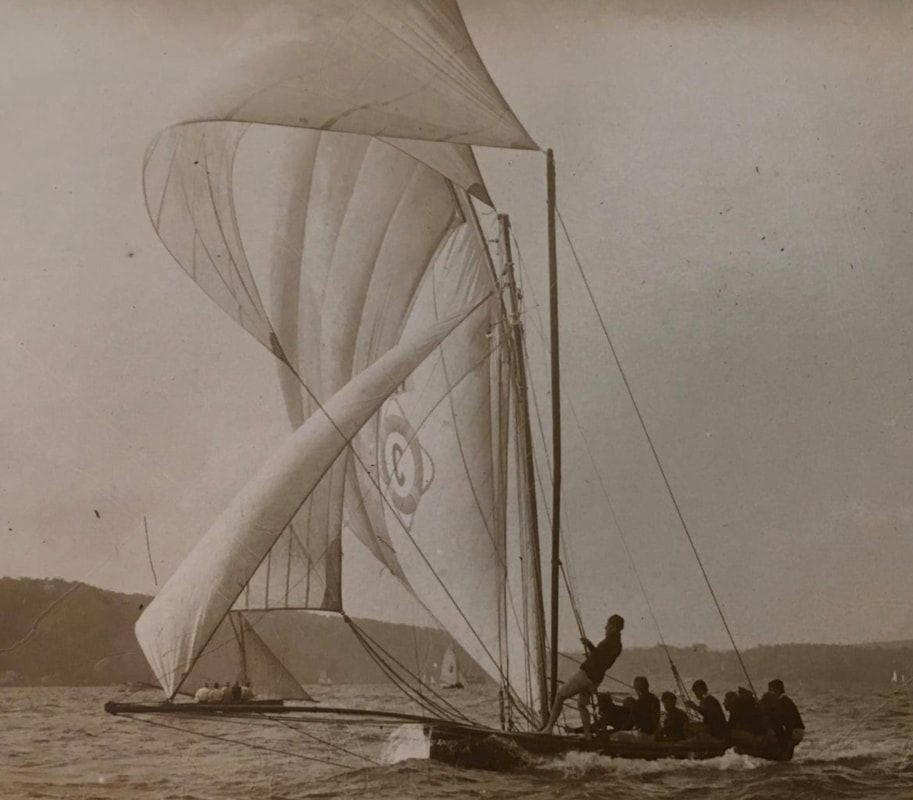The contest between NSW, Western Australia and Queensland 18-footers in Sydney in January 1913 was an eventful one, with a black Nor’Easter in the Championship race and a Southerly gale in a handicap race resulting in dismastings and other gear damage. Only four boats finished in the Championship, and only one in the handicap race, the West Australian boat Westana in a race that will always be remembered as “The Westana gale”.
Westana, one of two West Australian entrants in the Mark Foy Challenge Cup of 1913, recognised as the Australian Championship. She was second in the Championship but was the only boat to finish in a handicap race the following week which has gone into legend as the day of the "Westana Gale". ANMM Hall Collection. This shot must be from the third race, a light Nor'Easter.
My attention was drawn to this series when sailor and Australian Historical Sailing Skiff Association member Mick Northam turned up some photos and memorabilia from the family of one of the Queensland participants, a William Robinson.
The photos had notes attached identifying them as the Pastime crew from Queensland in 1913. The memorabilia included an invitation to W Robinson to a garden party at Mark Foy’s residence in Bellevue Hill for Friday 25 January 1913. But Pastime came down for an interstate race a year earlier in 1912 and was sold to a Sydney owner. This mystery was quickly solved when I discovered that the original builder/owner/skipper of Pastime, Frank W Coleman built another 18-footer he named Colonial in the winter and brought it down for the 1913 Interstates, bringing essentially the same crew that he had brought with Pastime the year before. So it appears to be another case of the drift that often happens in family stories, the two trips have been conflated. But it’s a great collection of images and memorabilia and Mick Northam is donating it to the Sydney Flying Squadron.
But before we get onto the story of the races, the collection included a photograph that I had already seen in the Harry Thompson Collection at the SFS of an 18-footer where the photographer caught the exact moment after the spinnaker pole snapped, which I had posted before on the OOPS! Page. The boat’s sail insignia cannot be seen, but the Robinson family photo identified it as Pastime. But seeing that they had already mistaken the boat’s name, and the fact that neither Pastime or Colonial appears to have broken a pole while in Sydney, I have to doubt the identification. It is possible that the breakage had not been reported, but there are only a couple of races in the 1912 and 1913 series that were held in a fresh Nor’Easter as depicted in the photo. One spinnaker problem was reported in the Championship race in 1913 for a Sydney boat Hero, but the contemporary report doesn’t exactly match the image, so I guess the boat will have to remain unidentified.
But before we get onto the story of the races, the collection included a photograph that I had already seen in the Harry Thompson Collection at the SFS of an 18-footer where the photographer caught the exact moment after the spinnaker pole snapped, which I had posted before on the OOPS! Page. The boat’s sail insignia cannot be seen, but the Robinson family photo identified it as Pastime. But seeing that they had already mistaken the boat’s name, and the fact that neither Pastime or Colonial appears to have broken a pole while in Sydney, I have to doubt the identification. It is possible that the breakage had not been reported, but there are only a couple of races in the 1912 and 1913 series that were held in a fresh Nor’Easter as depicted in the photo. One spinnaker problem was reported in the Championship race in 1913 for a Sydney boat Hero, but the contemporary report doesn’t exactly match the image, so I guess the boat will have to remain unidentified.
You can just see the middle section of the spinnaker poles hitting the water near the bow wave. It may be Pastime, but is probably not.
Queensland had dropped out of Interstate, or rather Intercolonial contests after being thoroughly beaten in 14’s, 18’s and 22-footers in Sydney in 1899, other than sending the second-rate Aeolus down as the sole Queensland representative in the 1903-04 season. Western Australia picked up the baton with the Perth Flying Squadron Challenge Cup in Perth in the 1906-07 season where the sole Interstate representative Australian (II) (Chris Webb NSW) was beaten into second by a different Aeolus steered by Ted Tomlinson. Chris Webb reversed the positions in Sydney in 1907-08, and won again in Perth in 1908-09 and Sydney in 1909-10. In this last series the Queenslanders joined in again, but it was only due to Frank Coleman who brought his self-built Ariell down at his own expense, but the boat was well-beaten under H Drake. In the winter of 1910 Coleman built Pastime to replace Ariell which he had donated to the Queensland Flying Squadron and it had been bought by H Drake who had steered it in Sydney. Two Sydney boats Advance and Arthur were shipped to Brisbane for an Interstate series in the 1910-11 season but Pastime won easily under Charlie Crouch (Ariell was second).
The West Australians (Chris Garland in Westana) took out the 1911-12 Championship in Perth with Nimrod the sole NSW rep coming second under Charlie Hayes. Frank Coleman had shipped Pastime to Sydney to race in what was simply termed an Interstate contest a week later but was soundly beaten. Pastime had won the Anniversary Regatta handicap the week before (the same day of the race in Perth). Pastime was left in Sydney for sale and was bought in August 1912 by W Cook. Meanwhile Coleman had started building his third 18-footer which he called Colonial, and began to win races in Brisbane in the first part of the 1912-13 season. Colonial was picked to represent Queensland in Sydney in the Mark Foy Challenge Cup of 1913 which was considered the Australian Championship as two West Australian boats were coming over, the current holder Westana under Chris Garland and Eurus under Ern Tomlinson. Norm Wright’s new Vanity was also picked to join Colonial representing Queensland. Vanity’s lines are reproduced in The Open Boat book.
The visitors were well-catered for in Sydney with many social events as well as three races, one of which was to be the Championship. In fact it was the first race, on Saturday 18 January 1913. As well as the four interstate boats there were four NSW representatives, Australian, Kismet, Arline and Pastime, which earned the right to join the team by coming third in the SFS Championship in November 1912 under Jack Smith, but some complaints were heard that it had been built in Queensland.
The West Australians (Chris Garland in Westana) took out the 1911-12 Championship in Perth with Nimrod the sole NSW rep coming second under Charlie Hayes. Frank Coleman had shipped Pastime to Sydney to race in what was simply termed an Interstate contest a week later but was soundly beaten. Pastime had won the Anniversary Regatta handicap the week before (the same day of the race in Perth). Pastime was left in Sydney for sale and was bought in August 1912 by W Cook. Meanwhile Coleman had started building his third 18-footer which he called Colonial, and began to win races in Brisbane in the first part of the 1912-13 season. Colonial was picked to represent Queensland in Sydney in the Mark Foy Challenge Cup of 1913 which was considered the Australian Championship as two West Australian boats were coming over, the current holder Westana under Chris Garland and Eurus under Ern Tomlinson. Norm Wright’s new Vanity was also picked to join Colonial representing Queensland. Vanity’s lines are reproduced in The Open Boat book.
The visitors were well-catered for in Sydney with many social events as well as three races, one of which was to be the Championship. In fact it was the first race, on Saturday 18 January 1913. As well as the four interstate boats there were four NSW representatives, Australian, Kismet, Arline and Pastime, which earned the right to join the team by coming third in the SFS Championship in November 1912 under Jack Smith, but some complaints were heard that it had been built in Queensland.
The start of the Mark Foy Challenge Cup Championship race on Saturday 18 January 1913. From a postcard collected by Graeme Ferguson in the AHSSA Collection, and also up on the FLEETS Page. Westana (Black Swan) has the best of the start, Australian and Kismet to her left with rectangles (Union Jack and Australian Blue flag), the two crescents are Arline and Vanity. The horseshoe is Pastime and the C in Lifebuoy is Colonial. Eurus is obscured beyond Colonial. Only four boats finished.
The day dawned with the promise of a Nor’Easter, and Australian, Arline and Vanity all fronted with big rigs. By the time they started the Nor’Easter was getting quite fresh. Kismet was first to the Sow and Pigs, Colonial was second. Pastime burst their jib early. Australian broke their gaff jaws and retired. The breeze built into a classic black Nor’Easter. Arline rounded the bottom mark at Clark Island and snapped her mast, closely followed by Vanity doing the same thing. Westana split a lee cloth on the first run but continued. Kismet under Billy Dunn led most of the way to beat Westana (Chris Garland) by over 4 minutes. WA’s other entrant Eurus (Ern Tomlinson) was third and Colonial steered by Frank Coleman himself was fourth, and no other boats finished.
The Westana Gale
The crews had a week to recover, but filled it with social events. A handicap race was scheduled for Saturday 25 January with Kismet on scratch and Australian, Nimrod, Westana, Eurus, Colonial and Golding all on 2 minutes or less. Golding, Enid, Vanity, Eurus and Colonial all had big sails on (Vanity must have repaired their mast or borrowed one), but the rest of the fleet had second sails. The big rig choice looked good when the race started in a light Nor’Easter, but a big Southerly came in when the fleet was approaching Shark Island at the end of the first run. Long-marker Enid was leading but their jib carried away after rounding Shark. Several boats lowered away. Frank Coleman gybed Colonial at the Clark Island mark in third place to huge cheers from the ferry for his pluck, but they snapped their mast before Bradley’s Head. Australian was ahead of Golding, with Westana well behind. Leading on the thrash from Taylor Bay to Shark Australian mis-stayed several times and then capsized. Golding snapped their mast. This left only Westana and Scot, but Scot withdrew, leaving Westana to finish alone.
The third race of the series, another handicap race was on the following Monday, the Anniversary Day Regatta. This one was run in a light Nor’Easter, in fact the race was held in the late morning before the sea breeze could amount to much. Australian (Chris Webb) won off scratch, followed by Lilian, Scot and Golding. All of the visiting boats were unplaced.
The Westana Gale
The crews had a week to recover, but filled it with social events. A handicap race was scheduled for Saturday 25 January with Kismet on scratch and Australian, Nimrod, Westana, Eurus, Colonial and Golding all on 2 minutes or less. Golding, Enid, Vanity, Eurus and Colonial all had big sails on (Vanity must have repaired their mast or borrowed one), but the rest of the fleet had second sails. The big rig choice looked good when the race started in a light Nor’Easter, but a big Southerly came in when the fleet was approaching Shark Island at the end of the first run. Long-marker Enid was leading but their jib carried away after rounding Shark. Several boats lowered away. Frank Coleman gybed Colonial at the Clark Island mark in third place to huge cheers from the ferry for his pluck, but they snapped their mast before Bradley’s Head. Australian was ahead of Golding, with Westana well behind. Leading on the thrash from Taylor Bay to Shark Australian mis-stayed several times and then capsized. Golding snapped their mast. This left only Westana and Scot, but Scot withdrew, leaving Westana to finish alone.
The third race of the series, another handicap race was on the following Monday, the Anniversary Day Regatta. This one was run in a light Nor’Easter, in fact the race was held in the late morning before the sea breeze could amount to much. Australian (Chris Webb) won off scratch, followed by Lilian, Scot and Golding. All of the visiting boats were unplaced.
A great photo of Coleman's Colonial (Queensland). This must also have been from the third race day. From the Harry Thompson Collection, Sydney Flying Squadron.
All visitors returned home after this eventful series, but the damaging season wasn’t over. Another Southerly gale on 10 March capsized and damaged so many 18’s that Donnelly was the only boat left and was declared the winner. The famous yacht Thelma was wrecked on Dobroyd Head in this gale and popular yachtsman Walter Moore was drowned.
Colonial returned to racing in Brisbane but did not race beyond the next season. Her mast and spars were sold to the owner of the new Norman Wright boat Langman (whose lines are also in The Open Boat book). Chris Webb again won the Championship in Perth the following season, this time with Australian III. Queensland’s Vanity was second, and Westana third. This was the last Championship held for a while because of the Great War.
Colonial returned to racing in Brisbane but did not race beyond the next season. Her mast and spars were sold to the owner of the new Norman Wright boat Langman (whose lines are also in The Open Boat book). Chris Webb again won the Championship in Perth the following season, this time with Australian III. Queensland’s Vanity was second, and Westana third. This was the last Championship held for a while because of the Great War.
